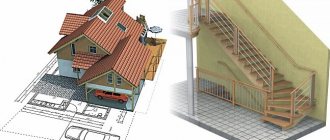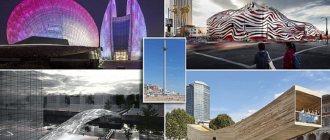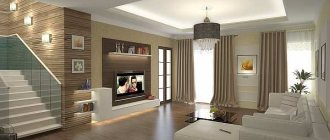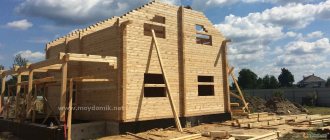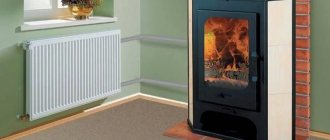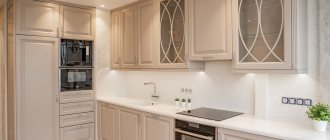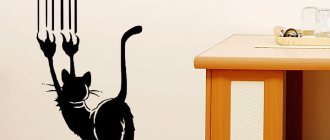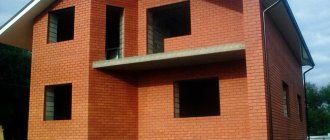Read in the article:
- Warm monolith
- Most active
- Natural Balance
- PKB - the same wood, only warm
- First certified
- Exactly according to the rules
- Based on a standard project
Just a few years ago, when they were just starting to talk about technologies for building an energy-efficient house, many developers perceived it as something completely fantastic. Build a passive house in Russia? Skeptics spoke about the conservatism of domestic builders and the untested technology. And the brave and progressive moved energy-efficient construction forward
Today in Russia, not only individual houses are being built, but also entire villages of energy-efficient cottages. Before giving examples of completed projects, we suggest remembering how it all began. The technology for constructing passive buildings came to us from Germany. But a passive house (German: Passivhaus) is not just a new modern technology. In Germany, a voluntary standard (Passivhaus Standard) has been developed, which defines the requirements for the design and construction of such facilities. The Passivhaus Institute is promoting this technology and adapting it to Russian conditions, which helps domestic builders master Passivhaus in practice.
Before starting to understand the technology itself, it was necessary to overcome the resulting confusion in terms. How to call such houses: passive, energy-passive, conditionally passive, energy efficient? Today we have decided on the terminology. Let us recall that the main criterion for assessing a passive house is the specific consumption of thermal energy for heating during the heating period, calculated per year. According to this standard indicator, according to the classification adopted in Europe, houses with low (36–50 kWh/m²) and ultra-low heat consumption (16–35 kWh/m²), passive (15 kWh/m²), and also with zero energy consumption and positive energy balance.
At first, some domestic development companies, realizing the promise of energy-efficient construction, rushed to call their new facilities passive. But actually it is not
None of the houses built in Russia using Passivhaus technology is pure Passivhaus. For one simple reason - the indicators indicated above have not been achieved. In order for such houses to be considered passive, the value of the standard indicator should be reconsidered taking into account Russian climatic conditions, which are more severe than European ones. After all, even if we strictly observe all the features of passive house technology, we are unlikely to be able to achieve a value of 15 kWh/m².
Specialists from the Passivhaus Institute, trying to still follow German standards, explained that objects built in Russia using Passivhaus technology should be called houses with low or ultra-low heat consumption. However, in practice these terms have not taken root. And today the term “energy efficient” is used in everyday life. If we summarize everything that has been written about an energy efficient home (EEH), we can say that it is a broader concept that denotes a tendency to save resources consumed by a building. Energy-efficient houses can be built using various technologies, but the main principle of designing such objects will inevitably be the use of all possibilities for storing heat in them in order to minimize energy costs. Now let’s look at the features of some energy-efficient private house projects implemented in Russia.
Property information
Object: residential building with a total area of 246 m²
Design and construction:
Materials and equipment: permanent formwork, reinforcement, concrete, Neopor polystyrene foam, waterproofing, energy-efficient windows and doors, Zehnder recuperator (Germany), Nibe heat pump (Sweden)
House box cost: RUB 25,000/m²
The wall “pie” of the house is a multi-layer structure (from the inside out): a layer of expanded polystyrene 50 mm thick, supporting a frame made of monolithic reinforced concrete, a layer of expanded polystyrene (100 mm) and 150 mm of energy-efficient polystyrene foam “Neopor”, covered with facade plaster
The house has windows with wooden frames and thermal insulation liners made of polyurethane foam. Double-chamber double-glazed windows are filled with argon, and a selective heat-reflecting transparent coating is applied to the surface of the outer and inner glass. The window frames are separated from the concrete enclosing structures by a layer of expanded polystyrene (permanent formwork), and on the outside they are adjacent to a layer of “Neopor”, which almost completely eliminates the possibility of cold bridges.
In energy-efficient homes, heating and ventilation systems are closely related to each other. This facility uses a supply and exhaust ventilation system with heat recovery. The recuperator, in combination with a horizontally buried ground heat exchanger, works both for air heating and cooling (in the hot season).
Calculations of energy consumption at home were carried out by German specialists. Thus, the calculated specific energy consumption for heating was 24 kWh/m² per year. If we compare this with the cost of heating a city apartment, then the cost per 1 m² of space in the city is 8 times higher. Experience in operating an energy-efficient monolithic house has shown that all expectations for heat savings were fully justified.
2
Most active
This facility stands apart among the energy-efficient houses built in our country and is a test and exemplary building not only in the Moscow region, but throughout Russia. The Active House philosophy is based on three key principles: energy saving, a healthy microclimate and respect for nature. Like Passive House, the Active House concept was developed in Europe. However, this project was initially adapted to the conditions of central Russia. The terms of reference for the design of the Active House defined energy saving requirements that were unprecedented for the Moscow region - three times higher than the normative ones. More precisely, the heat transfer resistance of walls is increased by almost 4 times, the basement floor by 3.3 times, the pitched roof by 3 times, and the windows by 2.8 times.
Warm roof installation
As you know, warm air masses in a room always rise. Therefore, insulation of not only the foundation, walls, but also roofs is required. Especially if the attic space is residential or used for other purposes. In winter it will be better to retain the necessary heat, and in summer it will be cooler.
The whole process is not very complicated if you know how to make a warm roof for a house correctly. The structure itself will consist of many layers. Waterproofing and windproofing are installed during the installation of the roof. It is necessary to protect the insulation from condensation. Since temperature changes and exposure to sunlight cannot be avoided. For this purpose, special polypropylene films are used, vapor-permeable, with special coatings.
Next comes thermal insulation. Typically, glass wool or polystyrene foam boards with the best characteristics are selected. The next layer is a vapor barrier necessary to protect the insulation. Since moisture, getting on such a material, neutralizes its beneficial properties. All this should be taken into account before making a warm roof for a house, and take care of the quality of the materials used.
Insulating a house with mineral wool - see here
Property information
Total area:
230 m²
Organizers:
COUNTRY PROJECT and VELUX
Architects:
experimental laboratory POLYGON
Detailed design of wooden structures:
"NLK Domostroenie"
Scientific support and testing:
"PASSIVE HOUSE INSTITUTE" (Russia)
Materials:
wooden structures (NLK Domostroenie), insulation "Framework P-32" (ISOVER), vapor barrier Delta-Reflex (DÖRKEN), wind insulation, polymer PVC membrane Monarplan FM (ICOPAL), heat-treated board, windows and solar collectors VELUX, thermal DANFOSS pump, GAULHOFER vertical windows, SOMFY and DECOR-CITY sun protection, WINDOWMASTER smart home system, ZEHNDER GROUP hybrid ventilation system, SCHIEDEL chimney
Energy efficiency indicators have been improved due to high-quality and most reliable insulation, and the use of renewable energy sources helps to significantly reduce energy consumption
Section of an “active house”
In architectural terms, the building has a solid volume and a set of protruding elements (porch, balcony, mezzanine, chimney). The house is oriented west - east and has an offset slope facing south, thanks to which the solar collectors installed in the roof can be used as efficiently as possible. All living spaces face south, the glazing area is increased both due to vertical and attic windows. The southern facade can rightfully be called an “active facade”, because it itself is rebuilt depending on weather conditions and the needs of the inhabitants of the house. Automatic sun shading systems open, increasing surface illumination and heating of rooms using solar energy, and close, preventing overheating on hot days.
The building is built on a pile foundation with a grillage, and the walls are based on a frame made of laminated coniferous wood. One of the secrets to the energy efficiency of a home lies in the features of the “pie” of the wall. The thickness of the frame is three times larger than usual - 550 mm, excluding layers of internal and external finishing. It is designed to minimize heat loss and ensure the tightness and rigidity of the building. The walls are a load-bearing wooden frame lattice structure with thermally insulated voids. Twelve layers of Isover “Frame P-32” slab insulation, which has the lowest thermal conductivity coefficient (and is specially designed for frame houses), make it possible to achieve the thermal protection indicators specified by the project. The floors and roofing also have an increased thickness of thermal insulation: 650 mm for the basement, 240 mm for the interfloor and 600 mm for the roof.
The use of a geothermal heat pump for heating has reduced energy costs and reduced the negative impact on the environment. The use of solar collectors in parallel with this pump makes heating, cooling and hot water supply to the home even more efficient and economical.
3
Natural Balance
Some ED pilot projects were accused of the fact that their architecture was far from Russian traditions. ROCKWOOL decided to prove that energy-efficient construction is cost-effective and can also be applied to traditional buildings. The Natural Balance country cottage was built in just six months. This is a one-story house with a residential attic, intended for one family.
The basis of the house is a strip monolithic foundation. The 0.5 m high plinth is a three-layer brick structure with a middle layer of insulation. Thermal insulation thickness is 150 mm. The floors of the first floor are also insulated. The walls of the building are constructed from aerated concrete blocks. The facade was made ventilated in accordance with the project.
Floor insulation in a frame cottage
Blowing is the main enemy of frame houses. Small gaps lead to significant heat loss. Accordingly, special attention must be paid to the construction of the floor covering. The method of insulation will depend on the type of foundation, the quality of the soil, and its moisture content. In order for the warm floor in a frame house to perform its functions with a strip foundation, it is possible to lay a lower layer of expanded clay on top of the insulation. In this case, there must be air vents.
But more often a wooden floor is installed, the basis of which is logs. Then the insulation is laid between them and sewn up with plywood. After this, the final decorative coating is applied. Sometimes, in order to have a truly warm floor in a frame house, it is necessary to lay special insulating films. They protect the coating from penetration of moisture and cold. The optimal choice of building materials will depend on the design features of the building. Therefore, advice from experienced experts will never be superfluous.
Property information
Total area: 186 m²
Energy efficiency class: A
Reduced energy consumption by 78.5% compared to a building of the same area built using traditional technology
Thermal resistance indicators:
Rfoundation = 3.6 m²°C/W, Rwalls = 5.2 m²°C/W
Rroof = 6.1 m²°C/W, Rwindows = 0.79 m²°C/W
Various types of thermal insulation are used in house designs. This is explained by the fact that specialized material has higher technical characteristics than universal
Ventilated façade design
This facility has energy-saving windows with a five-chamber profile 76 mm thick. Double-glazed windows are filled with inert gas, and the inner glass has a low-emissivity coating. When designing the building, we used the principles of “solar” architecture: most of the windows are oriented to the south.
Heating and hot water supply is provided by a geothermal pump. Taking heat from the ground for its own heating, the house uses it very wisely. Instead of traditional radiators, a low-temperature water heated floor system was installed in the rooms. Although the use of energy-efficient technologies increased the cost of construction by 22%, this is not too high a price to pay for living comfortably in a warm, environmentally friendly house and annually saving more than 22,000 rubles on heating and hot water supply.
The external walls were built from aerated concrete blocks, the façade was made ventilated
The house is heated using underfloor heating
Heating and hot water supply is provided by a geothermal pump
4
PKB - the same wood, only warm
Implemented projects of energy-efficient wooden houses have also appeared. As you know, any building made of solid wood does not meet the requirements for energy efficiency of buildings contained in SNiP 02/23/2003. The solution to the problem was a modern material that combines all the inherent advantages of wood and complies with standards for thermal resistance - passive laminated veneer lumber (PKB). This is a profiled laminated timber with effective insulation (CARBON XPS). It is glued inside the lamellas, and additional stiffening ribs are not used to prevent cold bridges from appearing. The efficiency of PCB with a cross-section of 200 × 180 mm compared to laminated veneer lumber of the same cross-section in terms of heat saving is 10 times higher.
If the house is cold, it needs to be insulated
It is not always possible to make a house warm during the construction phase. There may be design errors, changes in operating conditions, requirements for the building by the owners, and much more. The problem of additional home insulation is especially relevant for those homeowners who purchased a ready-made house on the secondary market. It is simply impossible to obtain objective information about how warm the premises are in winter until you spend the winter there yourself.
Insulation of the house
If the problem has become obvious, you can make the house warm with your own hands. To do this, you need to determine what the house is built from, what type of insulation is best, and how to install it correctly. And then the matter remains small.
Property information
Object: residential building with a total area of 650 m²
Design and construction: JSC Green Wood House
Materials and equipment: screw piles, PCB timber, holofiber insulation, steam and waterproofing, bitumen shingles, energy-efficient windows and doors, recuperator, heat pump, solar collectors
Total cost of the house: 17,000,000 rubles.
Total cost of equipment: heat pump, solar collector (three panels), supply and exhaust ventilation with heat recovery, storage tank, Astra-8 septic tank, components, air ducts and fittings, heat exchangers - RUB 1,271,052.
Since PCB is lightweight, buildings made from it do not require a strong foundation. The house we want to talk about used a foundation on screw piles
Assembling a cottage box has its own characteristics. It is performed without “corners”, using a technology called “City corner”. Its essence is as follows: the walls of the house frame are connected to each other by sawing the ends of the beams at 45°, and the partitions are sawed into the walls without outlets to the outside. The advantages of such a corner connection are the absence of cold bridges in the corners of the building due to a continuous layer of insulation and significant savings on materials (10–15%). Holofiber, a modern thermal insulation material made of polyester, based on fibers in the form of a spiral spring, was used as inter-crown insulation.
What makes a home energy efficient? First of all, the absence of cold bridges and a sealed thermal circuit, which is created thanks to effective insulation materials located inside the timber, between the crowns and in other structural elements of the building. The heat transfer resistance of a 200 mm thick PCB wall, according to the test protocol carried out by certified bodies, is 5.9 m² ° C/W. This is a very high figure - almost twice as high as required by SNiPs for central Russia.
The second component is energy-efficient windows and doors. In this case, windows were installed with a heat transfer resistance of 1.6 m² °C/W and doors with a heat transfer resistance of 1.8 m² °C/W. The translucent structures installed in the house are distinguished by an innovative approach to their manufacture: a specially designed thermal chamber using new insulation and sealing materials reduces heat loss and eliminates the formation of cold bridges. The width of the window frame is 200–250 mm. It adapts to the thickness of the walls of the house, so no additional elements are required on the inside or outside. Hidden fittings allow you to create a two-frame structure without reducing the light opening.
The third mandatory element of a passive house is supply and exhaust ventilation with heat recovery. A 12 kW geothermal heat pump is used to heat the premises. The heating system also includes vacuum solar collectors (SC), which are also used for the cottage’s hot water supply. This became possible due to the installation of a water heated floor system. It is combined with a heat pump and solar collectors, which further increases its efficiency by 15%.
Warm corner made using City Corner technology
Creating a laminated timber frame
5
First certified
As already mentioned, there are no special materials from which only an ED can be built. Here, for example, is an example of fast, high-quality and economical energy-efficient construction of a frame building. The creators of the project were faced with the task of building a house with a specific annual energy consumption for heating of no more than 50 kWh/m². The basis of this object was a spatial frame made of dried laminated wood. It is designed in such a way as to minimize heat loss, ensure structural rigidity and eliminate cold bridges. Its peculiarity (in contrast to the standard “framework”) is that the wall does not have wooden posts passing through the entire contour. The total thickness of thermal insulation in the walls is 358 mm. To insulate all the main structural elements, fiberglass-based mineral wool “ISOVER Karkas-P-32” was used, which has a low thermal conductivity coefficient λB = 0.03 W/m °C and was developed specifically for frame houses in the Moscow region.
The best construction technologies
The best construction technology is the construction of a frame base, which does not require additional waste and insulation measures. The basis is a reliable block of polystyrene permanent formwork connected by jumpers. To prevent the room from blowing in and to retain heat in winter, a layer of sound insulation is added to the floor.
The construction of brick housing is carried out using the laying of supporting and finishing bricks and insulation. Such a building has an increased heat capacity. It can be heated in a few hours, and the room temperature remains the same throughout the night. The technology does not use mineral wool, which does not allow moisture to pass through well, is susceptible to destruction, and creates a greenhouse effect.
In order to comply with the standards for supplying heat to a residential building when designing, it is necessary to study Federal Law No. 261-FZ. A cold, drafty building wastes a lot of fuel. Therefore, heating becomes expensive for owners and also depletes national resources.
Property information
Object: two-story residential building with a total area of 162.5 m²
Organizers: DPK "Trekhrechye"
Detailed design of the building frame: NLK Domostroenie
Scientific support and testing: Passive House Institute LLC (Russia)
Materials and engineering systems: wooden structures (“NLK Domostroenie”), thermal insulation “ISOVER Frame-P-32” (Saint-Gobain CIS group), steam and windproof films SOLITEX UD/MENTO, Intello+ and SOLITEX WA “PLASTEX” , windows - REHAU (profile), Glass Europe and Glass Team (glazed unit), supply and exhaust ventilation system with heat recovery ZEHNDER, chimney SCHIEDEL, vacuum solar collectors "ATMOSPHERE"
Cost of the object: 10,002,400 rubles.
Thanks to the design features, heat losses are minimized. The heat transfer resistance indicator is: Rroof - 12.8 m² °C/W, Rwall - 8.7 m² °C/W, Rfloor - 8.9 m² °C/W
Ventilation scheme with heat recovery
Special energy-saving double-glazed windows using two Planibel Top N+ low-emissivity glasses, meeting the requirements of certified passive house analogues, were used as translucent elements.
For this facility, we chose a Zehnder Comfosystems ventilation system with heat and humidity recovery from ZEHNDER (Germany). The joint operation of the ventilation unit and the geothermal heat exchanger ensures an actual efficiency of 88% based on monitoring results. For hot water supply to the house, vacuum solar collectors installed on the roof are used.
As for heating, since main gas is not supplied to the facility, after comparing the costs of using various heating sources, we settled on low-temperature electric convectors with thermostats. In any standard home this would be too expensive, but not in an energy efficient one. According to the certificate of compliance of the property with the criteria of an ultra-low energy house, issued by Passive House Institute LLC, the building will consume less than 35 kWh/m² per year.
Frame made of wooden beams
Spatial frame made of laminated wood
Fiberglass-based mineral wool was used for thermal insulation of all structural elements
Geneo window profiles
6
Exactly according to the rules
This object is an excellent example for those who want to understand what an energy-efficient house is. The building was designed and constructed according to all the features of Passivhaus technology. A powerful monolithic reinforced concrete slab with a reverse grillage ensures uniform distribution of the load on the base of the house, the mass of which, taking into account monolithic columns, walls, cladding and snow loads, is about 1000 tons. The walls are made of solid ceramic bricks of grade M250. The thickness of the masonry is 400 mm.
What to build a house from to live in winter?
Cottages built of wood and brick can be considered the warmest. The remaining materials have a lot of advantages and, most importantly, allow you to build a house much faster and cheaper, but they can cause inconvenience to the owner in the winter.
To prevent this from happening, it is important to follow the recommendations of experts:
- observe the presence of deformations of the external and internal finishing;
- avoid moisture getting inside the walls;
- do not turn off the heating in winter;
- timely treat walls with special means and replace insulation.
If these conditions are met, frame and block houses will also delight you with warmth and comfort in winter for many years.
Did you find this article helpful? Please share it on social networks: Don't forget to bookmark the Nedvio website. We talk about construction, renovation, and country real estate in an interesting, useful and understandable way.
Property information
Object: residential building with a total area of 379.3 m² in the Wright Park cottage village
Design and construction:
Materials and equipment: reinforcement, concrete, waterproofing, solid ceramic brick grade 250, Neopor insulation (BASF), FOAMGLAS® foam glass blocks, Schöck Isokorb® elements, CREATON ceramic tiles, NELISSEN hand-molded bricks, VIKING windows and doors, heat-treated board
Let us dwell on two important points that are necessary components of the Passivhaus technology and require strict adherence during the construction process. The first is a powerful continuous thermal insulation circuit of the building. To create it, it is not enough to use a calculated layer of effective insulation. First of all, you should get rid of cold bridges at the junction points. This problem is usually solved using the “perforation” method (due to local cold bridges). But in houses built using Passivhaus technology, this technique negates the positive effect of high-quality wall insulation. We have to completely abandon balconies and other architectural details that extend beyond the thermal contour of the building. Therefore, an alternative solution was developed for passive houses - load-bearing thermal insulation elements Schöck Isokorb®. At this site they were installed along the perimeter of the first floor floor slab. They perceive and transmit acting loads to it, while thermally cutting off protruding parts from the thermal contour of the house.
The second important point that needs to be discussed is the use of FOAMGLAS® foam glass insulation. It was placed in one of the most problematic places in the structure of a brick house - at the junction of the foundation and wall masonry. Here, at the base of the wall, a cold bridge is formed, leading to its waterlogging. The solution to the problem is the technology of closing the thermal circuit of the building, that is, connecting the external thermal insulation with the thermal insulation of the floor or ceiling. Traditional insulation is not suitable for this purpose. The best option is foam glass, an incompressible material that does not shrink under constant load and does not change its geometric dimensions. Neopor polystyrene foam boards were used to insulate the walls and ceilings.
All window structures and balcony doors in the house consist of wooden frames with energy-saving inserts and double-glazed windows with hard selective coating and argon filling
I would like to draw your attention to an important feature of window installation. They were installed not directly into the opening of a brick load-bearing wall, but into a wooden box protruding from the opening. This makes it possible to install windows with the required position relative to the dew point. In addition, the protruding frame of the box allows Neopor boards to be tightly fitted to it to ensure a tight joint.
And finally, a few words about engineering communications. The building is heated using a highly efficient VIESSMANN condensing gas boiler and REHAU hydronic underfloor heating. To control the temperature and humidity conditions in the room, a supply and exhaust ventilation unit with heat recovery, Komfovent REGO 1200 HW, is used. The operation of boiler equipment, timely switching on and off of heated floors, heating and fresh air supply are controlled by devices of an intelligent control system certified according to the pan-European KNX/EIB standard.
7
Based on a standard project
She presented her version of an energy-efficient house. It was decided to adapt the frame-panel technology, which the company has been using to build its facilities since 1986, to the requirements of Passivhaus. The wall structure in the base house consists of a wooden frame, on which basalt insulation is laid, covered from the inside of the room with a vapor barrier film, and on both sides the “pie” of the wall is completed by sheathing made of cement-bonded particle board.
Features of modern insulation
You can make your home warmer yourself using roll or panel insulation. They are mounted on a vertical or horizontal grille, on a plate-shaped dowel-umbrella. Some types of materials are applied using sprayers or expensive construction equipment.
You can choose the type of insulation by studying its characteristics. In modern construction, exterior wall decoration is carried out with the following materials:
- Mineral insulation is an environmentally friendly and non-flammable material that is suitable for finishing any surface;
- Polystyrene or polystyrene foam is an economical material, suitable for insulating brick and aerated concrete surfaces, has a high degree of flammability;
- Eco-wool is a fire-resistant and environmentally friendly material, applied by spraying;
- Polyurethane foam - suitable for additional insulation of a wooden building, processing its frame and cracks, resistant to steam penetration;
- Ceramic insulation - applied by painting or spraying, creates 1-5 mm of unbreakable film.
Ceramic insulation is suitable for owners of designer buildings with uneven walls, broken lines, and spherical elements.
Advantages and disadvantages of a water heating system
The main disadvantage of water heating in a private home is the need to purchase a large number of different materials. Namely: pipes, shut-off valves, fittings, radiators, boiler and circulation pump. The latter is not used in all systems.
And other shortcomings that can be described as nonsense if the owner of the house is indifferent to his home:
- Water leaks during operation. Today this situation is rare because plastic pipes have been replaced by plastic pipes. But even they sometimes leak at the junctions with other materials. These are already claims against the installation manufacturer.
- The water inside the system may freeze if it is not drained for the winter. This situation is for houses that are not used during the cold season.
Plastic pipes have solved many problems
Water heating has more advantages, which is why the majority of developers of new houses choose it:
- uniform distribution of heat throughout all rooms;
- installing one heating boiler makes it possible to control the process from one place;
- all equipment, except radiators, and piping can be made hidden. That is, organize a boiler room in the office space, and hide the pipes in grooves on the walls or in the floor. Using a heated floor system generally solves the problem of hidden installation. Even the radiators will not be visible;
- The coolant temperature does not exceed +95°C. And the surface of the batteries heats up to +65°C. You can’t get burned on them; dust doesn’t burn on them;
- water heating produces soft heat.
Heating system with hidden pipe wiring
